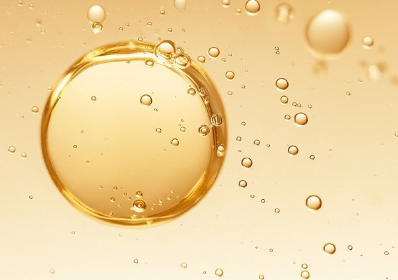Vitamin E: Lipid Antioxidant & Skin Protector
What Is Vitamin E?
Vitamin E refers to a group of fat-soluble compounds (tocopherols and tocotrienols), with α-tocopherol being the most biologically active form in human tissues. As a lipid-soluble antioxidant, it localizes in cell membranes and lipid domains, making it uniquely suited to protect skin lipids from oxidative damage.
Mechanism of Action in Skin
1. Free Radical Scavenging
- In membranes containing unsaturated lipids, reactive oxygen species (ROS) and lipid peroxyl radicals (ROO•) can propagate chain lipid peroxidation.
- α-Tocopherol donates a hydrogen atom to lipid peroxyl radicals, neutralizing them and forming a tocopheroxyl radical as an intermediate.
- The tocopheroxyl radical can be reduced back to active vitamin E by other antioxidants (e.g. ascorbic acid / vitamin C), thereby regenerating its protective ability.
2. Barrier Stabilization & Membrane Protection
- By intercepting lipid radicals, vitamin E helps preserve the integrity of cell membranes and skin barrier lipids, reducing damage to structural lipids and maintaining barrier function.
- It also may influence membrane fluidity, modulate lipid packing, and support enzymatic / protein components in membranes.
3. Anti-inflammatory & Photoprotective Effects
- Topical vitamin E reduces UV-induced erythema (redness), edema, and skin swelling, likely via its antioxidant action and by modulating inflammatory mediators (e.g. COX-2, interleukins) in keratinocytes.
- Certain vitamin E forms (e.g. γ-tocopherol) may inhibit COX-2 activity beyond antioxidant effects, contributing to anti-inflammatory and photoprotective actions.
- Some evidence suggests antitumorigenic effects in skin, potentially linked to its radical scavenging and modulation of signaling pathways.
Effects on Skin Function & Appearance
- Protection against photoaging: by reducing UV-induced oxidative damage to lipids and proteins in skin.
- Barrier enhancement & hydration: Vitamin E improves moisture retention, helping reduce transepidermal water loss (TEWL) in damaged or dry skin.
- Modulation in skin disease: Some clinical and observational studies link lower serum vitamin E levels with chronic inflammatory skin diseases (psoriasis, atopic dermatitis, vitiligo, acne).
- Wound healing / scarring: The evidence is mixed. Some use vitamin E topically for scars, but controlled studies show little benefit and possible irritation.
Research Highlights
Topical absorption: α-Tocopherol application increased vitamin E levels ×62 in the epidermis and ×22 in the dermis.
-
Distribution: Highest accumulation occurred in the lipid-rich epidermis; lower but measurable diffusion into dermis.
-
Bioavailability: Confirms that topical vitamin E penetrates and is retained effectively in skin layers.
-
Functional relevance: Positions α-tocopherol at the surface where UV-induced ROS are generated.
-
Mechanistic implication: Establishes the prerequisite antioxidant reservoir that enables UV protection and reduced lipid peroxidation
Conclusion:
Topical α-tocopherol demonstrates strong skin bioavailability and antioxidant efficacy. By accumulating primarily in the epidermis, it establishes a protective reservoir that neutralizes UV-induced oxidative stress, limits lipid peroxidation, and supports endogenous antioxidant defenses. Collectively, vitamin E preserves collagen integrity, maintains barrier function, and protects against photo-aging, confirming its therapeutic and cosmeceutical value for skin health.






